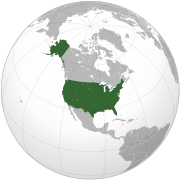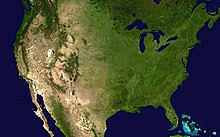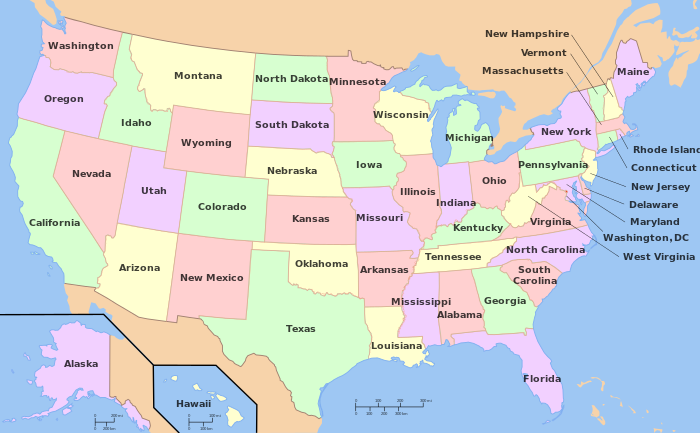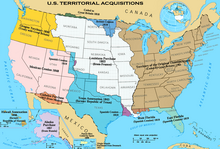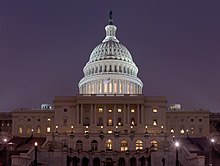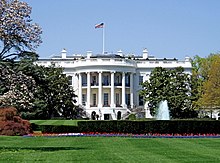Overview of and topical guide to the United States
An orthographic projection of the United States. The following outline is provided as an overview of and topical guide to the United States:
United States of America North America , and the world's third-largest country by both land and total area. It shares land borders with Canada to its north and with Mexico to its south and has maritime borders with the Bahamas , Cuba , Russia , and other nations. With the Soviet Union's collapse and the subsequent end of the Cold War in 1991, the United States emerged as the world's sole superpower.
Geography of the United States
An enlargeable topographic map of the contiguous United States
Location (50 states ):
Northern Hemisphere and Western Hemisphere (except western Aleutian Islands )
Time zones :
Extreme points of the United States :
North: Point Barrow , Alaska 71°23′15″N 156°28′52″W / 71.38750°N 156.48111°W / 71.38750; -156.48111 (AK-N Point Barrow )
South: Ka Lae , Island of Hawai'i , Hawai'i (18°54′39″N 155°40′52″W / 18.91083°N 155.68111°W / 18.91083; -155.68111
East: Sail Rock, just offshore West Quoddy Head , Maine 44°48′54″N 66°56′52″W / 44.81500°N 66.94778°W / 44.81500; -66.94778
Physically East: Eastern Semisopochnoi Island, Alaska 51°57′40″N 179°46′29″E / 51.96111°N 179.77472°E / 51.96111; 179.77472
West: Peaked Island, offshore Cape Wrangell , Attu Island , Alaska 52°55′00″N 172°26′00″E / 52.91667°N 172.43333°E / 52.91667; 172.43333
Physically West: Western Amatignak Island, Alaska 51°16′06″N 179°09′00″W / 51.26833°N 179.15000°W / 51.26833; -179.15000
High: Denali (Mount McKinley ), Alaska at 6,194 meters (20,322 ft) 63°4′10″N 151°0′26″W / 63.06944°N 151.00722°W / 63.06944; -151.00722
Low: Badwater Basin , Death Valley , California at −86 meters (−282 ft) 36°13′58″N 116°46′42″W / 36.23278°N 116.77833°W / 36.23278; -116.77833 Land boundaries: 12,034 km (7,477 mi) Canada 8,893 km (5,525 mi)[note 1] Mexico 3,145 km (1,954 mi)[1] Coastline: 19,924 km (12,380 mi)
Environment of the United States
An enlargeable satellite composite image of the contiguous United States . Lush temperate, subtropical, and tropical vegetation and low to moderately high mountains prevail throughout the humid east, and high mountains, plateaus, temperate and subtropical savannas , and hot dry deserts prevail in the west.
Geographic features of the United States
Regions of the United States
Physiographic divisions of the United States
The geography of the United States varies across their immense area. Within the continental U.S., eight distinct physiographic divisions exist, though each is composed of several smaller physiographic subdivisions.[2]
Laurentian Upland – part of the Canadian Shield that extends into the northern United States Great Lakes area.Atlantic Plain – the coastal regions of the eastern and southern parts includes the continental shelf, the Atlantic Coast and the Gulf Coast .Appalachian Highlands – lying on the eastern side of the United States, it includes the Appalachian Mountains , Adirondacks and New England province.Interior Plains – part of the interior contentintal United States, it includes much of what is called the Great Plains .Interior Highlands – also part of the interior contentintal United States, this division includes the Ozark Plateau.Rocky Mountain System – one branch of the Cordilleran system lying far inland in the western states.Intermontane Plateaus – also divided into the Columbia Plateau , the Colorado Plateau and the Basin and Range Province , it is a system of plateaus, basins, ranges and gorges between the Rocky and Pacific Mountain Systems. It is the setting for the Grand Canyon , the Great Basin and Death Valley .Pacific Mountain System – the coastal mountain ranges and features in the west coast of the United States .
Administrative divisions of the United States
States of the United States
At the Declaration of Independence , the United States consisted of 13 states , former colonies of the United Kingdom. In the following years, the number of states has grown steadily due to expansion to the west, conquest and purchase of lands by the American government, and division of existing states to the current number of 50 United States :[3]
Map of the United States with state border lines. Alaska and Hawaii are shown at different scales, and that the Aleutian Islands and the uninhabited northwestern Hawaiian Islands are omitted from this map.
Territories of the United States
Location of the insular areas of the United States: The United States of America
Incorporated unorganized territory
Unincorporated organized territory
Unincorporated unorganized territory
Freely associated commonwealth
Incorporated organized territories
Incorporated unorganized territories
Unincorporated organized territories
Unincorporated unorganized territories
Baker Island , uninhabitedHowland Island , uninhabitedJarvis Island , uninhabitedJohnston Atoll , uninhabitedKingman Reef , uninhabitedBajo Nuevo Bank , uninhabited (disputed with Colombia )Serranilla Bank , uninhabited (disputed with Colombia)Midway Islands , no indigenous inhabitants, currently included in the Midway Atoll National Wildlife Refuge Navassa Island , uninhabited (claimed by Haiti )Wake Atoll consisting of Peale, Wake and Wilkes Islands,[4] Marshall Islands )
Geography of the states and territories
AK – AL – AR – AZ – CA – CO – CT – DC – DE – FL – GA – HI – IA – ID – IL – IN – KS – KY – LA – MA – MD – ME – MI – MN – MO – MS MT – NC – ND – NE – NH – NM – NV – NJ – NY – OH – OK – OR – PA – RI – SC – SD – TN – TX – UT – VA – VT – WA – WI – WV – WY
AS – GU – MP – PR – VI
Demography of the United States
AK – AL – AR – AZ – CA – CO – CT – DC – DE – FL – GA – HI – IA – ID – IL – IN – KS – KY – LA – MA – MD – ME – MI – MN – MO – MS MT – NC – ND – NE – NH – NM – NV – NJ – NY – OH – OK – OR – PA – RI – SC – SD – TN – TX – UT – VA – VT – WA – WI – WV – WY
AS – GU – MP – PR – VI
Climate of the United States
History of the United States
John Trumbull 's Declaration of Independence Declaration of Independence , but it actually shows the drafting committee presenting its work to the Congress.A map of the territorial evolution of the United States
Period-coverage
History of the states and territories
AK – AL – AR – AZ – CA – CO – CT – DC – DE – FL – GA – HI – IA – ID – IL – IN – KS – KY – LA – MA – MD – ME – MI – MN – MO – MS MT – NC – ND – NE – NH – NM – NV – NJ – NY – OH – OK – OR – PA – RI – SC – SD – TN – TX – UT – VA – VT – WA – WI – WV – WY
AS – GU – MP – PR – VI
History of cities
Presidents of the United States
Government and politics in the United States
Federal government
Legislative branch
The United States Capitol
Executive branch
The White House
Federal executive departments
All departments are listed by their present-day name and only departments with past or present cabinet-level status are listed. Order of succession applies only to within the cabinet; the vice president has always been first in the line of succession, and the Speaker of the House and the President pro tem of the Senate have at times been included.
Department
Creation
Order of
Modifications since creation
2007 Budget
Employees (2007)
State
1789
1
Initially named "Department of Foreign Affairs"
9.96
30,266
Treasury
1789
2
11.10
115,897
Defense
1947
3
Initially named "National Military Establishment"
439.30
3,000,000
Justice
1870
4
Position of Attorney General created in 1789, but had no department until 1870
23.40
112,557
Interior
1849
5
10.70
71,436
Agriculture
1889
6
77.60
109,832
Commerce
1903
7
Originally named Commerce and Labor; Labor later separated
6.20
36,000
Labor
1913
8
59.70
17,347
Health and Human Services
1953
9
Originally named Health, Education, and Welfare; Education later separated
543.20
67,000
Housing and Urban Development
1965
10
46.20
10,600
Transportation
1966
11
58.00
58,622
Energy
1977
12
21.50
116,100
Education
1979
13
62.80
4,487
Veterans Affairs
1989
14
73.20
235,000
Homeland Security
2002
15
44.60
208,000
Total budget (fiscal year 2007):
1,523.42
4,193,144
Commissions
Judicial branch
The United States Supreme Court building
State and territory governments
AK – AL – AR – AZ – CA – CO – CT – DC – DE – FL – GA – HI – IA – ID – IL – IN – KS – KY – LA – MA – MD – ME – MI – MN – MO – MS MT – NC – ND – NE – NH – NM – NV – NJ – NY – OH – OK – OR – PA – RI – SC – SD – TN – TX – UT – VA – VT – WA – WI – WV – WY
AS – GU – MP – PR – VI
Politics of the states and territories
AK – AL – AR – AZ – CA – CO – CT – DC – DE – FL – GA – HI – IA – ID – IL – IN – KS – KY – LA – MA – MD – ME – MI – MN – MO – MS MT – NC – ND – NE – NH – NM – NV – NJ – NY – OH – OK – OR – PA – RI – SC – SD – TN – TX – UT – VA – VT – WA – WI – WV – WY
AS – GU – MP – PR – VI
Foreign relations
International organization membership
Military
The Pentagon
Intelligence organizations
Headquarters of the Central Intelligence Agency
